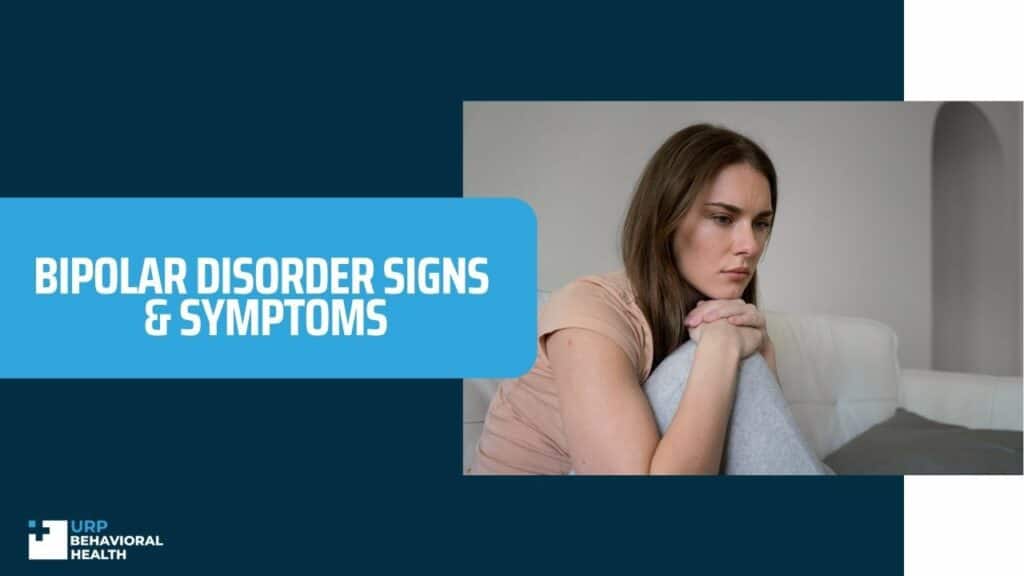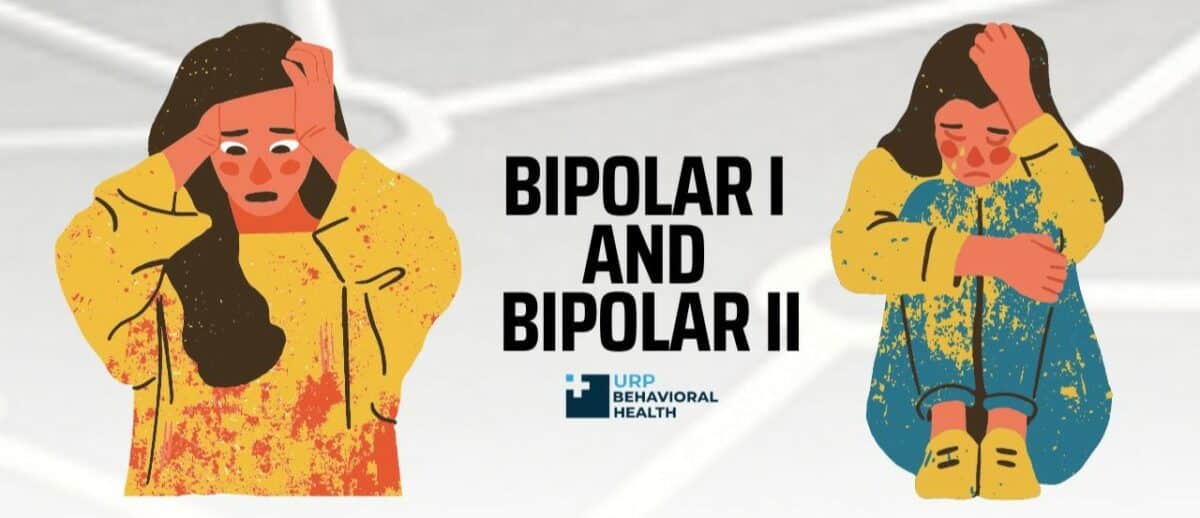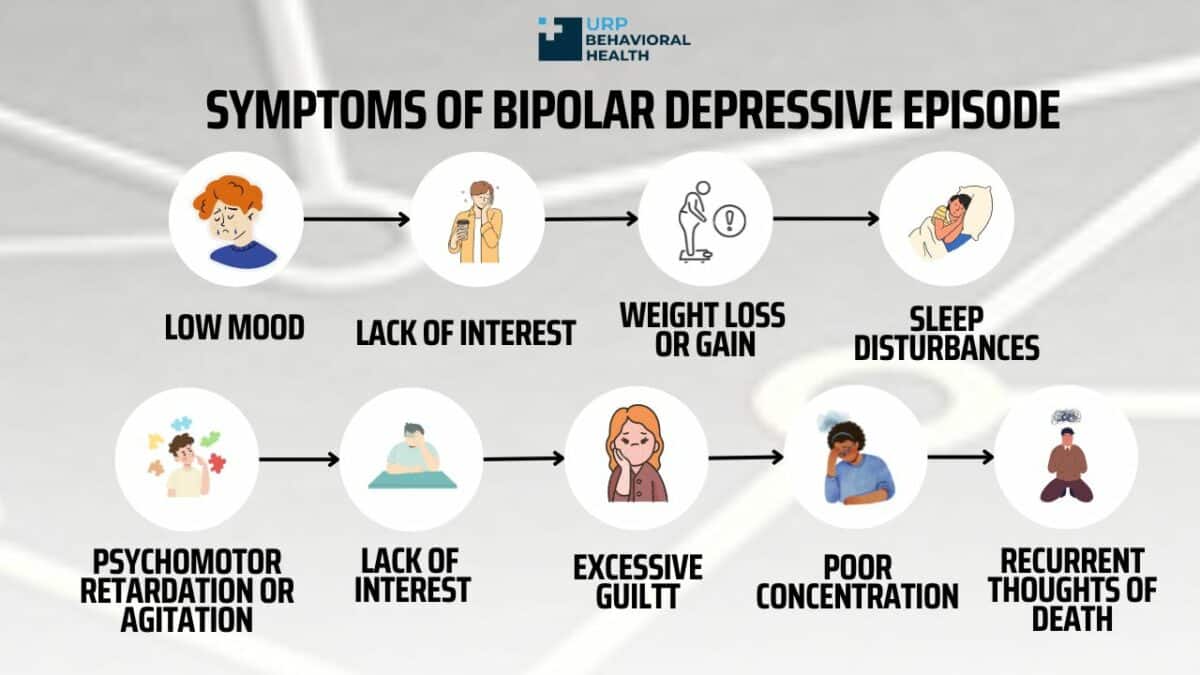Bipolar Disorder Signs & Symptoms

Everyone experiences fluctuations in their mood from time to time, but what happens when they become more severe than typical mood swings? Bipolar disorder is characterized by unusual and significant changes in not just your mood but your ability to concentrate, energy levels, and motivation. It can affect your ability to perform everyday functions and impacts different areas of your life, such as work, school, and social relationships.
For a deeper understanding of how bipolar disorder impacts people, let’s look at its different signs and symptoms


Bipolar I and Bipolar II
Diagnosing Bipolar Disorder
To diagnose you with bipolar I disorder, your specialist at URP Behavioral Health will compare your symptoms with those in the DSM-5. For a bipolar I diagnosis, you need to meet the criteria for a manic episode. The manic episode can be followed or preceded by a hypomanic or major depressive episode.
But for a bipolar II diagnosis, you should meet the criteria for at least one hypomanic episode and one major depressive episode. Also, there should be no history of a manic episode.
Symptoms of Bipolar Manic Episode
Elevated or Irritable Mood
Your mood during a manic episode can be described as excessively cheerful and euphoric. Sometimes, your cheerful mood is excessive to the point that it leads to haphazard enthusiasm for interpersonal, occupational, and sexual interactions. One example is that you may spontaneously start conversations with strangers.
There are also instances when your mood becomes elevated, specifically if you’ve been using substances or if you’ve been denied something. At other times, you may experience rapid shifts in mood, called lability, over short periods of time.
Noticeable Change in Behavior
During this period, you should display at least three of the following symptoms in addition to elevated or irritable mood:
- Inflated Sense of Self: You think very highly of your abilities and knowledge, which drives you to feel like you’re better than everyone else. So, even if you lack any particular skill, talent, or experience, you may set off to take on difficult tasks like building an invention or writing a book.
- Decreased Need for Sleep: This is distinct from insomnia, which is when you want to sleep or feel sleepy by are unable to. During a manic episode, you only sleep a little, if at all, or wake up hours earlier than your usual time, feeling fully rested. In some cases, you can go on for days without sleep but won’t feel tired.
- Pressured Speech: Your speech during a manic episode becomes rapid, loud, and difficult for others to interrupt. You may talk continuously and in an intrusive manner without any regard for others.
- Racing Thoughts: You may feel like your thoughts are racing faster than you can express through words. This is also referred to as a flight of ideas, which is accompanied by accelerated speech.
- Distractibility: You’re unable to block out unnecessary external stimuli, which prevents you from focusing on a task, listening to instructions, or holding a conversation.
- Increased Activity Levels: This can be an increase in goal-directed activity, whether it’s at work, at school, or engaging in sexual activity. Or an increase in purposeless non-goal-directed activity.
- Engaging in Risky Activities: This refers to excessive involvement in risky activities that can result in painful consequences, such as shopping sprees or business investments.
These symptoms constitute a manic episode, and at least one lifetime episode is required for a diagnosis.

Symptoms of Bipolar Depressive Episode
During a depressive episode, you show:
- Low Mood: You may describe your mood as depressed, discouraged, and hopeless.
- Lack of Interest: You report feeling less interested in activities that you once enjoyed.
- Unintentional Weight Loss or Gain: Your appetite may increase or decrease significantly, leading to unintentional weight gain or loss.
- Sleep Disturbances: This refers to having difficulty sleeping or sleeping excessively. You may have trouble falling asleep, wake up in the middle of the night and be unable to fall back asleep or wake up too early.
- Psychomotor retardation or agitation should be observed by others. Psychomotor retardation includes slowed speech, thinking, and body movements, while agitation involves packing and the inability to sit still.
- Feeling fatigued without physical exertion, so even the smallest tasks require significant effort.
- Excessive guilt over minor failings from the past or unrealistic negative evaluations of your worth.
- Poor concentration, inability to think, and experiencing difficulty in making decisions.
- Recurrent thoughts of death, suicidal ideation, and suicide attempts.
For a depressive episode, you should experience at least five of these symptoms during a 2-week period. At least 1/5 should be the first or second symptom.
Our Bipolar Disorder Treatment Center
To receive a diagnosis of bipolar disorder, you must meet the established diagnostic criteria. Your psychiatrist will assess whether you experience the symptoms defined in the Diagnostic and Statistical Manual of Mental Disorders, Fifth Edition (DSM-5).
- Advantages of Inpatient Treatment
- Controlled Environment
- 24/7 Supervision
- Regular Psychiatric & Medical Assessments
- Multidisciplinary Treatment Team
- Chef-Prepared Nutritious Meals
- Evidence-Based & Integrative Therapies
- Outdoor Picnic & Relaxation Areas
- Secure Outdoor Spaces for Recreation
- Contemporary Design with Safety Measures
- Exercise Equipment Available On-Site
Bipolar Disorder Symptoms in Children and Teens
Detecting symptoms of bipolar disorder in children and teens is different because these age groups are already prone to having mood swings. During a manic episode, adolescents may display symptoms like:
- Expressing intense feelings of happiness
- Acting immature and intensely silly for their age
- Talking at a rapid pace about different things
- Have a hard time falling asleep but don’t get tired
- Have trouble concentrating at school and have racing thoughts
- Engaging in risky, thrill-seeking behavior
- Have an inflated sense of knowledge and ability, which makes them seem overconfident
During a depressive episode, adolescents may show symptoms such as:
- Frequent pangs of sadness for no reason
- Increased feelings of irritability and hostility
- Complains of physical pain and fatigue
- Sleeping excessively
- Trouble concentrating in class
- Feelings of hopelessness and worthlessness
- A notable change in appetite that leads to unintentional weight loss or gain
- Little interest in activities they previously enjoyed
- Have thoughts about suicide and death
Additionally, children and teens with bipolar disorder have trouble maintaining everyday functions and relationships. They may perform poorly at school, and caregivers may complain about significant changes in attitude and mood.
Common Bipolar Disorder Symptoms in Women
Current statistics by the National Institute of Mental Health show that around 2.8 percent of American adults have had bipolar disorder in the past year. Although males and females have a similar prevalence rate of about 2.9 and 2.8, respectively, each sex experiences the condition differently. Here’s how factors such as misdiagnosis, hormone levels, and co-occurring mental health disorders affect women with bipolar disorder.
To diagnose women with bipolar disorder, it’s important that they meet the criteria for symptoms as provided in the fifth edition of the APA’s DSM. For a diagnosis, you need to experience at least one episode of mania (bipolar I) or hypomania (bipolar II).
Manic or Hypomanic Episode
Mania is characterized by a euphoric mood, which may cause you to feel ‘high.’ Keep in mind that hypomania is less intense than mania, which can be severe enough to require hospitalization as a result of increased risk-taking behaviors.
During a manic episode, mood is typically described as excessively cheerful and euphoric. You may feel like you’re ‘on top of the world,’ and others may easily recognize your mood as excessive, especially when you show haphazard enthusiasm for interpersonal and occupational interactions. Usually, however, your predominant mood is irritable, especially when things don’t go your way or if your wishes are denied.
Hormonal Influences
Although both men and women have an equal likelihood of developing bipolar disorder, there are key differences in how they experience the condition. This, in turn, impacts the type of treatment plan recommended to women.
Relationship Between Thyroid Hormone Levels and Symptom Severity
Studies indicate that hormones play a role in the development of bipolar disorder in women. It can also impact the severity of manic and hypomanic symptoms. Moreover, women with bipolar disorder are at a higher risk of rapid cycling than bipolar men. Some researchers believe that this can be attributed to hormonal fluctuations during the menstrual cycle.
A study in the journal Frontiers in Psychiatry found a correlation between clinical bipolar disorder symptoms and thyroid hormone levels in female participants. Researchers found an inverse relationship, which meant that lower thyroid hormone levels indicated greater severity of bipolar disorder symptoms.
Menopause and Bipolar Disorder
During menopause, your progesterone and estrogen levels decrease, resulting in symptoms like hot flashes, anxiety, and, most commonly, mood changes. Research shows that the late onset of bipolar disorder in women can be associated with hormone fluctuations during menopause.
Similarly, women who already have a bipolar disorder diagnosis may experience an exacerbation in symptoms due to the menopause-related stressors. One study finds that women with the condition experienced worsening mood disturbances during the transition into menopause.
Bipolar Disorder and PMS
Researchers have also looked at the association between premenstrual symptoms and bipolar disorder. Studies have found that premenstrual syndrome can worsen bipolar disorder symptoms in women and that about 25 percent of women with bipolar disorder also meet the criteria for PMS. Fortunately, there’s evidence that adequate treatment for bipolar disorder can result in fewer mood fluctuations over the course of your menstrual cycle.
Bipolar Disorder and Postpartum Onset
The most significant link to an association between bipolar disorder and hormone levels is found during pregnancy and postpartum. Researchers suspect that women with a diagnosis of bipolar disorder are at a higher risk of experiencing postpartum psychosis.
One study finds that women who experienced a postpartum affective episode had a higher risk of developing bipolar disorder than women who had an affective episode outside the postpartum period. There’s also evidence that pregnancy can exacerbate bipolar symptoms. One study indicates that the risk of hospitalization for bipolar disorder is seven times higher during postpartum than in women who haven’t given birth. In some women, childbirth can trigger the onset of bipolar disorder, while in others who previously had the condition, it can cause a relapse.
Bipolar II Prevalence Among Women
Initial research showed that the lifetime prevalence of bipolar I disorder is around 1.3 percent, according to Epidemiologic Catchment Area Study data. On the other hand, recent reports indicate higher prevalence rates of about 3.7 and 6.4 percent for bipolar disorders. Overall, bipolar I disorder affects men and women at the same frequency. However, bipolar II disorder, rapid cycling BD, and bipolar depression occur more commonly in women.
A study in the American Journal of Psychiatry found that 29.6 percent of female participants with bipolar disorders experienced a rapid cycling course of the illness. This was in contrast to 16.6 percent of male participants with the condition. Researchers have found that women show more cyclicity, which implies frequent polarity shifts and intense mood instability.
The US Government’s Office on Women’s Health also reports that bipolar II disorder is more common in women. This type is marked by major depressive episodes and hypomanic episodes, which are briefer and milder manic episodes.
Misdiagnosis of Bipolar Disorder Among Women
A 2018 review from the Journal of the American Psychiatric Nurses Association finds that misdiagnosis is a common occurrence among people with bipolar disorder. In fact, it affects up to 40 percent of people with the condition. Even so, women are misdiagnosed at a higher rate than men.
Due to the higher prevalence rate of bipolar II disorder among women, they’re likely to be misdiagnosed with unipolar depression. There’s evidence to suggest that women are misdiagnosed for 1.9 years longer than men. This is possible due to the brief and mild nature of hypomanic episodes, which allows them to go unnoticed.
Misdiagnosis can prevent women from accessing adequate treatment and often exacerbates bipolar symptoms. People with bipolar disorder who are misdiagnosed with major depression may be prescribed antidepressants by their mental health practitioner. Studies show that antidepressant medication can cause manic episodes or rapid cycling in people with bipolar disorder.
Seasonal Mood Changes
The body’s circadian rhythms, which dictate sleep, hunger, and wakefulness, are impacted by sunlight and other environmental factors. Some people with bipolar disorder experience changes in their circadian and seasonal rhythms. This results in seasonal patterns of depressive and manic/hypomanic episodes.
A 2021 review from the journal Translational Psychiatry found that seasonal variations of bipolar disorder are a common occurrence among women. The review also finds that hospital visits for bipolar depressive episodes experience a sharp increase during the early winter months. Similarly, hospitals observed a sharp increase in hospitalizations for manic episodes during the warmer months.
Researchers also found that hypomanic episodes are much more sensitive to photoperiod variation. They noticed that the number of hospitalizations for hypomanic episodes increased during periods of maximum sunlight exposure.
Higher Likelihood of Mixed Episodes and Rapid Cycling
Mixed bipolar episodes are when you experience a high mood and depressive symptoms at the same time. Research indicates that mixed episodes occur frequently in females. Similarly, rapid cycling episodes, when your mood changes quickly in short periods of time, are common in females as well.
One review from 2015 shows that around 30 percent of women with bipolar disorder experience rapid cycling, compared to 16 percent of males. Prevalence information in the fifth edition of the DSM-5 shows that women with bipolar II disorder have a higher likelihood of alternating between episodes.
Co-Occurring Mental Health Disorders
Alcohol and Substance Use Disorder
A 2012 review found that women with bipolar disorder face a higher genetic risk of alcohol use disorder. Having both alcohol use disorder and bipolar disorder creates a higher risk of associated psychopathology and increased severity of depressive and manic symptoms.
This increased likelihood is based on a hypothesis that women with bipolar disorder use alcohol to self-medicate mood symptoms. Another explanation is that increased alcohol consumption is the result of a tendency to engage in impulsive behaviors.
The co-occurrence between bipolar disorder and substance use disorder could also be due to changes in brain functioning as a result of consistent substance use.
Eating Disorders
One study shows that women with a diagnosis of bipolar disorder face a higher rate of eating disorders. Researchers found that the presence of a lifetime comorbid eating disorder was linked to an earlier age of onset of mood symptoms and a history of rapid cycling.
Manic and hypomanic symptoms co-occur with disordered eating behaviors for different reasons. During manic and hypomanic episodes, you’re more likely to engage in harmful and impulsive behaviors such as binge eating and purging. Disordered eating behaviors co-occur during a depressive episode because some women may engage in restricted eating or overeating as a maladaptive coping skill.
Borderline Personality Disorder
Numerous reviews report that there’s an estimated 20 percent overlap in diagnostic frequency. This means 20 percent of people with BPD have bipolar disorder, while 20 percent of people with bipolar disorder have BPD. Therefore, many people with either condition have a comorbid diagnosis. The reason for this comorbidity is due to similarities between the two conditions, such as mood instability, which puts you at risk of developing another condition.
PTSD
In one 2020 study on people with bipolar disorders, researchers found that over 72 percent of participants reported experiencing a traumatic event. Moreover, about 37 percent of people also reported a PTSD diagnosis. Similarly, a 2017 research review shows that between 4 and 40 percent of people with a bipolar disorder diagnosis also meet the criteria for PTSD. It also found that women with bipolar I disorder had a higher likelihood of developing PTSD than bipolar II women.
Let Us Guide You Towards Healing
We know that seeking treatment can be overwhelming, but our staff is here to make the process as smooth as possible. We’re available 24/7 to address any questions or concerns you may have.









